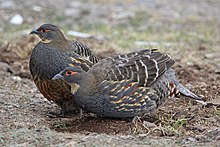Szechenyi's monal-partridge
| Szechenyi's monal-partridge | |
|---|---|

| |
| Scientific classification | |
| Domain: | Eukaryota |
| Kingdom: | Animalia |
| Phylum: | Chordata |
| Class: | Aves |
| Order: | Galliformes |
| Family: | Phasianidae |
| Genus: | Tetraophasis |
| Species: | T. szechenyii
|
| Binomial name | |
| Tetraophasis szechenyii Madarász , 1885 | |

| |
Szechenyi's monal-partridge (Tetraophasis szechenyii), also known as buff-throated partridge or buff-throated monal-partridge, is a member of the family Phasianidae in the order Galliformes. They are endemic to western China.[2]
Taxonomy
The common name, as well as the Latin binomial, of the Szechenyi's monal-partridge commemorates Graf Bela Szechenyi, a Hungarian explorer.[3] Complete mitochondrial genome sequencing of the species places the Szechenyi's monal-partridge in the genus Tetraophasis in the family Phasianidae. Phylogenetic positioning of the Tetraophasis has been understudied, though there is strong support that it and genus Lophophorus are sister genera, forming a subclade with Tragopan.[2]
Description
The Szechenyi's monal-partridge is a sexually monochromatic, medium-sized species of partridge. It has a distinct orange horizontal teardrop shaped eye ring, a light gold gorget, as well as a crest that it can occasionally flare up. The species has a grey upper chest and speckled orange and grey belly. They are usually 29–50 cm in length and weigh between 660-1790g.[4]
Distribution and habitat
The Szechenyi's monal-partridge is endemic to the high mountains (3350–4600 m) of western China, and is distributed in southeastern
Behavior
Diet:
The Szechenyi's monal-partridge's diet consists mainly of
Breeding:
The Szechenyi's monal-partridge is one of the few galliformes that participate in
Roosting:
The Szechenyi's monal-partridge not only participate in cooperative breeding, but they also engage in
Conservation status
Even though this species is in the Least Concern category by the current IUCN Red List;[13] under the Red Book of China, it is currently considered as endangered and listed in Category I of the nationally protected animals.[14] With Sichuan and Yunnan rapidly modernizing since the mid 70s, deforestation needs to be studied as a potential threat to this species. Logging companies have been clearing large areas of natural forest, with most of the trees being firs and spruce firs, which act as roosting sites for the Szechenyi's monal-partridge.[15] In order to focus on conservation efforts for the Szechenyi's monal-partridge, more information on the species' ecology and habitat use is needed. This information is fundamental to determine its conservation status.[14]
References
- . Retrieved 11 November 2021.
- ^ S2CID 83473796.
- OCLC 54616507.
- S2CID 42394645.
- ISSN 1938-4254.
- S2CID 85247982.
- ^ S2CID 243577202. Retrieved 2019-12-04.
- PMID 26784961.
- ^ a b Xu, Yang, Wang, Yue, Ran, Yu, Nan, Ying, Bisong, Jianghong (2010). "Roosting Behavior and Roost Selection by Buff-throated Partridges Tetraophasis szechenyii during the Breeding Season". Zoological Studies. 49: 461–469 – via ResearchGate.
{{cite journal}}: CS1 maint: multiple names: authors list (link) - S2CID 42394645.
- ^ S2CID 85247982.
- ^ Xu, Ran, Zhou, Yang, Yue, Wang, Yu, Jianghong, Xin, Nan, Bisong, Ying (2008). "The effect of temperature and other factors on roosting times of Szechenyi Monal Partridges Tetraophasis szechenyii during the breeding season". Ornis Fennica. 85: 126–134 – via ResearchGate.
{{cite journal}}: CS1 maint: multiple names: authors list (link) - .
- ^ ISSN 1712-6568.
- ^ "Saving Sichuan's trees". www.chinadialogue.net. 25 May 2011. Retrieved 2019-12-04.

